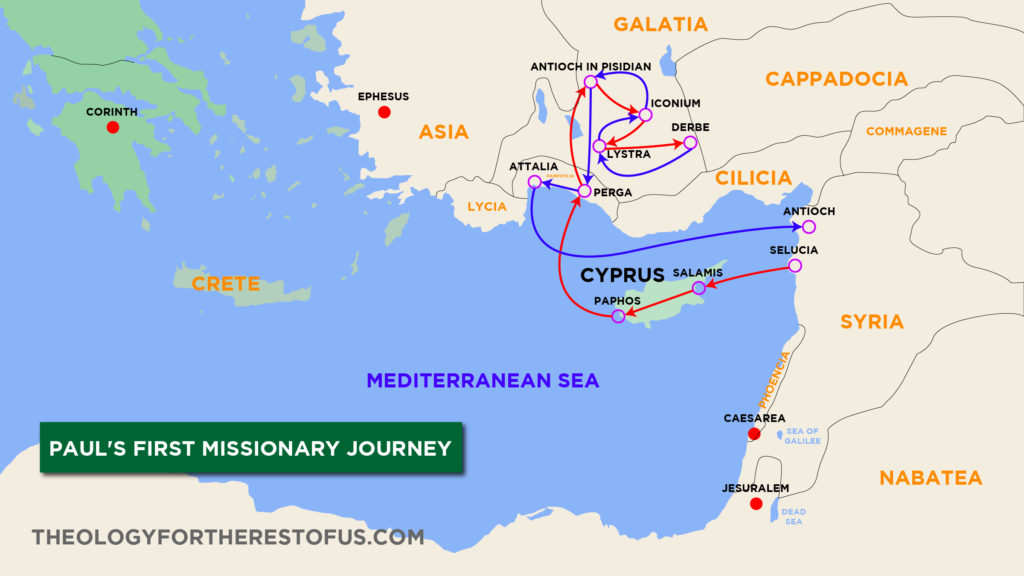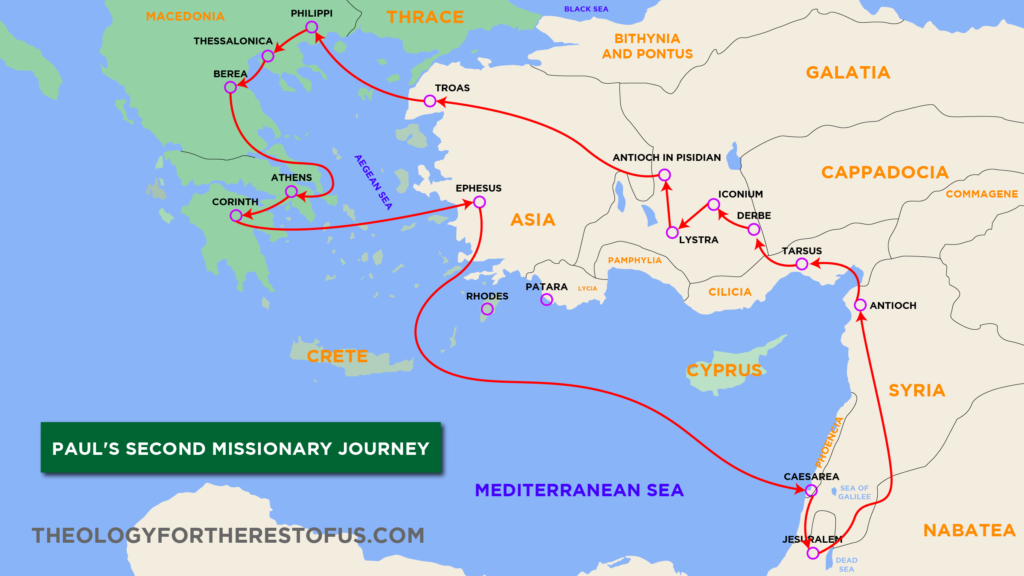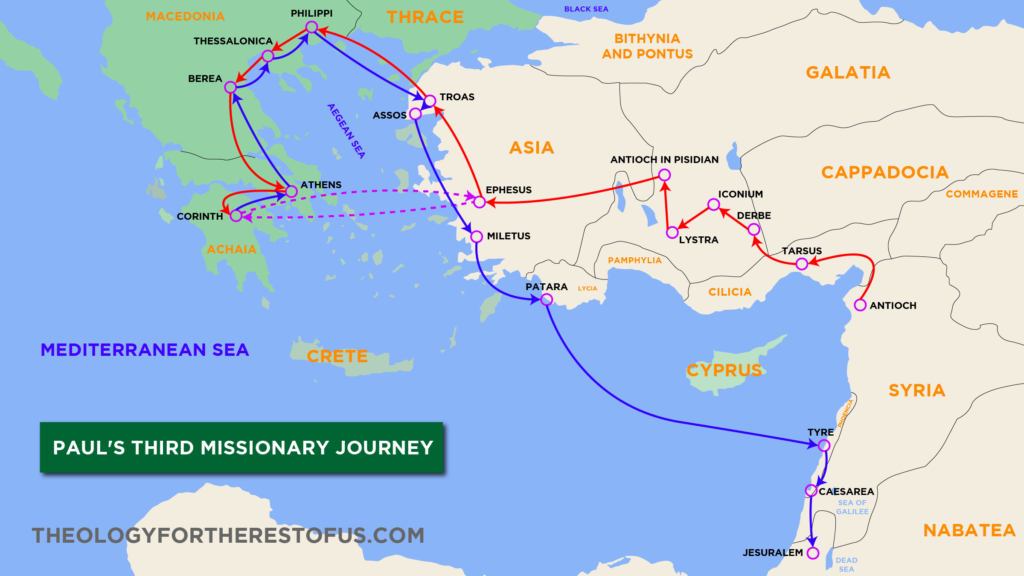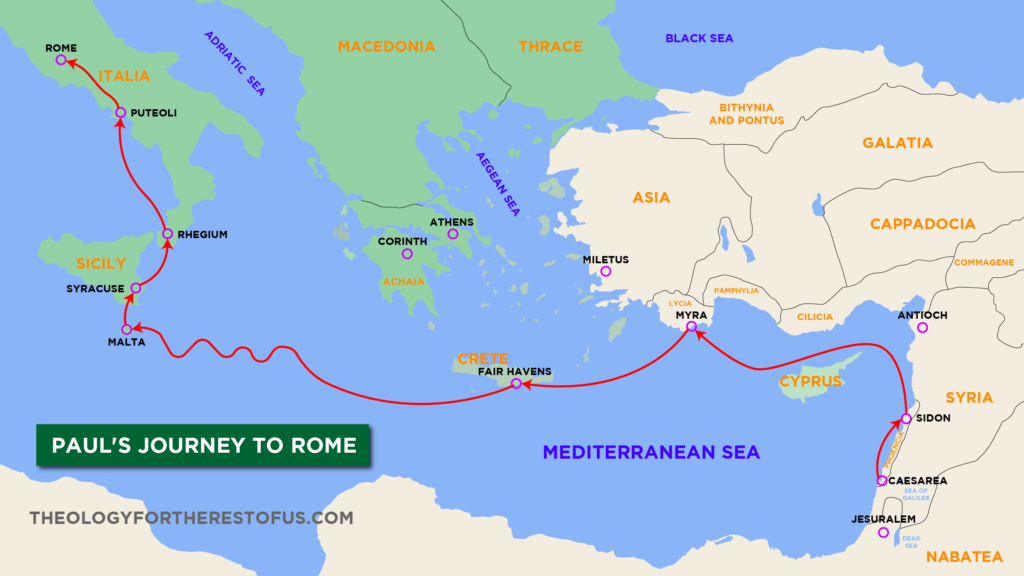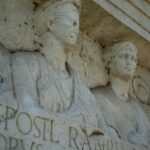
Paul’s Four Missionary Journeys: The Complete Guide
God did many amazing things through the life and ministry of the apostle Paul. The gospel was spread to many people across the known world thanks to Paul’s efforts, despite the severe opposition and persecution Paul faced.
What were Paul’s missionary journeys? Paul took four missionary journeys. Paul’s first three missionary journeys are recorded in the book of Acts. The fourth is alluded to in Paul’s letters. On the first missionary journey Paul went through Cyprus, Pamphylia, and Galatia. On his second missionary journey he went through Galatia, Macedonia, and Achaia. Paul’s third journey took him through Galatia, Asia, Macedonia, Achaia, and ended in Jerusalem. After his third missionary journey Paul was imprisoned in Caesarea for two years and later transported to Rome where he was then placed under house arrest for another two years. His fourth missionary journey is not clear, but it may have included Spain, Crete, Asia, Achaia, and Macedonia.
By looking at Paul’s missionary journeys we can look and reflect on the beginning of the fulfillment of God’s command to “Go therefore and make disciples of all nations” (Matthew 28:19).
Timeline of Paul’s Missionary Journeys
- A.D. 37: Converted on the road to Damascus
- A.D. 37-40: Spends three years in Arabia
- A.D. 40: Brief visit to Jerusalem to meet with the apostle Peter
- A.D. 40-44: Preaches and ministers in Tarsus and surrounding regions
- A.D. 44 or 45: Relocates to Antioch in Syria
- A.D. 45 or 46: Travels with Barnabas to visit Jerusalem, brings a famine relief offering
- A.D. 46 or 47: First missionary journey with Barnabas, likely lasts 1-2 years
- A.D. 50: Attends the Jerusalem Council
- A.D. 51: Leaves on second missionary journey, trip lasts 2.5 to 3 years, including 18 months in Corinth
- A.D. 54: Leaves on third missionary journey, trip lasts more than 4 years, including 3 years in Ephesus
- A.D. 58: Arrested in Jerusalem, put on trial before the Roman governor Felix
- A.D. 58-60: Held in Caesarea for two years
- A.D. 60: Put back on trial by Festus the new Roman governor; eventually transported to Rome
- A.D. 61: Arrives in Rome
- A.D. 61-63: Placed under house arrest for two years
- A.D. 63: Released from house arrest, likely launches his fourth missionary journey
- A.D. 66 or 67: Imprisoned in Rome again
- A.D. 67 or 68: Martyred under Nero’s persecution
*Dates are approximate.
Paul’s Background
Before he was known as the apostle Paul, he was first known as Saul of Tarsus. He was a brilliant, pious, zealous, and well-educated Pharisee, from a wealthy and well-connected family. Saul was obviously intimately acquainted with the Hebrew Scriptures, but was also thoroughly acquainted with Greco-Roman history, language, and culture.
Saul became famous in Palestine because of his persecution of Christians. But things changed, dramatically. By God’s providence, Saul became a Christian after a supernatural encounter with Jesus on the road to Damascus (Acts 9).
After Saul’s conversion, he traveled to a few different places, over several years, including three years in Arabia (Gal. 1:17–18), a brief visit to Jerusalem (Gal. 1:18), and then several years of preaching in the regions of Syria and Cilicia (Gal. 1:21).
Partnership with Barnabas
After some heavy persecution of the Christians in Jerusalem, some believers ended up living in the city of Antioch. They preached the gospel there and a “great number” believed in Jesus (Acts 11:21). When the apostles in Jerusalem heard about this, they sent a man named Barnabas to Antioch to serve in the church there (Acts 11:22).
Barnabas was a prophet (Acts 13:1) and an apostle (Acts 14:14). Through his ministry a “great number of people were brought to the Lord” (Acts 11:24).
After being in Antioch a while, Barnabas traveled to Tarsus to find Saul. Barnabas recruited Saul to come teach and lead and serve in the church in Antioch in Syria (Acts 11:25-26). Saul relocated to Antioch sometime between 44 and 46 A.D. and served as one of the leaders of the church there.
Barnabas and Saul would become ministry traveling partners for the next few years, including at least one earlier trip to Jerusalem (Acts 11:27-30) in order to bring a famine relief offering to the Christians in Jerusalem (likely sometime between 45 and 46 A.D.).
First Missionary Journey
Barnabas and Saul sensed the call of the Holy Spirit to go out on their first missionary journey (Acts 13-14). Sometime around 46 A.D. (or 47 A.D.), Barnabas and Saul were set apart by the Holy Spirit and sent out on their first missionary journey by the church at Antioch.
John Mark
Before Barnabas and Saul officially left on their first missionary journey, they recruited a young man named John Mark to go with them. John Mark was the son of a woman named Mary (mentioned in Acts 12:12). She owned the house where the Christians had been meeting and praying when Peter was miraculously delivered from jail by the angel.
It is likely that, as a young boy, John Mark had witnessed Jesus’ ministry first-hand. Sadly, however, during the missionary journey, John Mark would eventually abandon Barnabas and Saul. This would later lead to a significant dispute between Barnabas and Saul a few years in the future.
Cyprus
Barnabas and Saul sailed from Seleucia to the island of Cyprus, apx. 100 miles off the coast of Syria. They began by preaching to Jewish people in the synagogues of Salamis. The crew did ministry in several parts of the island until they got to Paphos (Acts 13:4-6).
During their ministry they faced significant opposition. One of their earliest opponents was a magician who was a Jewish false prophet. Saul performed a supernatural act that blinded this false prophet. These events led to the conversion of the Roman proconsul Sergius Paulus (Acts 13:6-12).
Saul Becomes Paul
After the events in Cyprus, the author of the book of Acts, Luke, begins to refer to Saul as Paul. Some Christians have asserted that Saul changed his name. However, it’s more likely that Saul and Paul were two different names for the same person all along; he was known by both names for many years.
After launching a Gentile-focused ministry, Paul would have been interacting with many Gentiles, and they would have likely preferred to refer to him by the Gentile name. It appears Luke sought to make this a point of emphasis. Scholar Greg Lanier says:
“When Saul Paul launches his Gentile-focused ministry among primarily Greek-speakers (beginning with Acts 13:9), it’s natural for Luke, the author of Acts, to begin referring exclusively to him by his Greek name. Nor is it surprising that he’s later referred to as ‘Paul’ in Jerusalem, since there were Greek speakers there too. Indeed, Luke could be making a thematic point by shifting from Saul to Paul around chapter 13, given the broader theme of Acts (e.g., 1:8). After all, the church’s nucleus is shifting from predominantly Jewish-centered Jerusalem to the Greek-centered ‘ends of the earth,’ such as Rome.”
Pamphylia and Galatia
Barnabas, Paul, and John Mark then traveled across the Mediterranean Sea to Perga in Pamphylia. This is where John Mark deserts Paul and Barnabas and heads back to Jerusalem (Acts 13:13).
From Perga, Paul and Barnabas then continued northward into the province of Galatia, coming to the city of Antioch in Pisidia (not to be confused with their home base city of Antioch in Syria).
Archaeologists have discovered an inscription containing the name ‘Sergius Paulus’ in the city of Antioch in Pisidia (he was the Roman proconsul that became a Christian back on the island of Cyprus). This is strong evidence that Sergius Paulus had family roots in Antioch in Pisidia. Some scholars have argued that he was the person that probably encouraged Barnabas and Paul to travel up to Antioch in Pisidia.
Once they arrived in Antioch in Pisidia, Paul went to the synagogue and preached about the good news of Jesus. Paul effectively preached in the synagogue for multiple weeks. This resulted in many people coming to faith in Jesus (Acts 13:14-44).
Unfortunately, Barnabas and Paul faced significant opposition there too. Part of the problem they faced was the jealousy of certain Jews. There were many Gentiles showing up to hear the gospel preached. Some Jews became jealous and started to contradict what Paul had to say. Since the Gentiles were more willing to hear what Paul had to say, he turned and preached to the Gentiles.
And when the Gentiles heard this, they began rejoicing and glorifying the word of the Lord, and as many as were appointed to eternal life believed. —Acts 13:48
The Gentiles’ response to the gospel was positive. The gospel continued to spread amongst Gentiles, but yet again the jealousy of the Jews became a significant issue. The Jews eventually drove Barnabas and Paul out of Antioch.
Iconium
After leaving Antioch in Pisidia, they traveled eastward, further into the Galatian region, arriving at the city of Iconium. There they preached and did miracles in the name of Jesus.
Very similar to what had happened in Antioch, Paul went into the synagogue in Iconium to teach and the result was that many Jews and Greeks believed in Jesus, but the unbelieving Jews there stirred up trouble against Paul, dividing the city (Acts 14:1-4). Barnabas and Paul left the city when they heard about attempts to stone them (Acts 14:5).
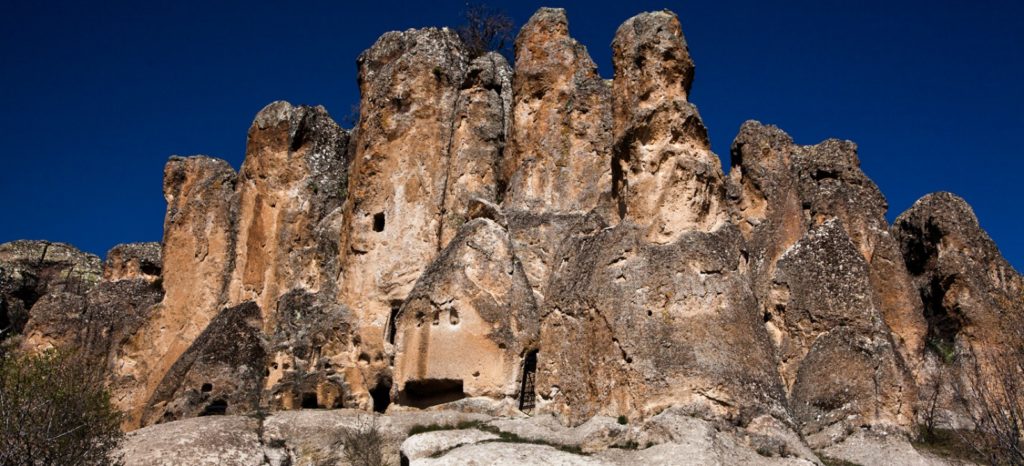
Lystra and Derbe
They then came to Lystra. There Paul performed a miracle causing a crippled man to walk again. When this occurred the people of the area assumed Barnabas and Paul were gods. The priest of Zeus brought animals to offer as sacrifices to Barnabas and Paul. When Barnabas and Paul realized what was happening, they tore their clothes in lament and told the people of the one true God (Acts 14:8-18).
The Jewish unbelievers from Antioch and Iconium had come to Lystra too, stirring up trouble. They convinced the people of Lystra to stone Paul and left him for dead outside the city. But Paul wasn’t dead. He got up walked back into the city (Acts 14:19-20).
The book of Acts doesn’t give us details about the events of that day when Paul walked back into the city, but I imagine the city’s residents were shocked. It was quite rare for anyone to survive stoning.
Barnabas and Paul then continued onto Derbe the next day. They preached and “won a large number of disciples” (Acts 14:21). Archeologists have discovered several inscriptions that show the Christian faith was a major presence in the city of Derbe after Barnabas and Paul’s visit.
Facing Tribulations for the Sake of Discipleship
Barnabas and Paul began their trek back home, but they decided that they’d first travel back through Galatia. When you look at a map, you see that it would have been much faster (and likely easier) to travel from Derbe directly to Antioch in Syria.
Derbe is less than 260 miles away from Antioch in Syria and less than 140 miles away from Paul’s original hometown of Tarsus. Barnabas and Paul could have traveled eastward through the region of Cilicia. Paul was very familiar with Cilicia and likely had friends throughout the region that could give them safe refuge along the way.
But Barnabas and Paul intentionally traveled more than 280 miles in the opposite direction of Antioch in Syria. Even though they had suffered great persecution in Galatia, they wanted to go back through the Galatian cities, before heading home, because they wanted to strengthen the disciples in those cities.
They returned to Lystra and to Iconium and to Antioch, strengthening the souls of the disciples, encouraging them to continue in the faith, and saying that through many tribulations we must enter the kingdom of God. —Acts 14:21-22
The journey through these cities for a second time gave them the opportunity to teach doctrine, establish elders in the churches, and pray with the believers.
After this, Barnabas and Paul then continued back down to Perga in Pamphylia. They preached in that region for a time. They eventually made their way over to the nearby port city of Attalia and sailed from there to Antioch in Syria (Acts 14:24-28).
Return to Antioch
Barnabas and Paul returned back home to Antioch in Syria stay there after the trip for “a long time” (Acts 14:28).
They had traveled more than 800 miles. Their first missionary journey had probably lasted between one and two years. When Barnabas and Paul arrived back in Antioch in Syria, they shared with everyone about the many people who had come to faith in Jesus and the churches that were established.

Jerusalem Council
After returning, Barnabas and Paul learned about a particular faction from Judea that had been confusing many Christians in the region by preaching a false gospel. This group had been preaching that, in order to become a Christian, the Gentiles must follow the Old Testament law, including circumcision (Acts 15:1).
Barnabas and Paul seem to have spent significant time disputing this false message and debated the Judean faction.
Eventually, this debate, about this false gospel, was appealed to the apostles in Jerusalem (Acts 15:2). This led to the Jerusalem Council (Acts 15:3-35), which likely took place sometime in 50 A.D. (some scholars date this event as early as 48 A.D. and some date it as late as 51 A.D.).
While traveling to Jerusalem for the council, Barnabas and Paul made stops along the way throughout Phoenicia and Samaria, encouraging believers wherever they went.
At the council, all the apostles concluded that the Gentiles do not need to follow the Jewish laws in order to become Christians. Barnabas and Paul (as well as several other men who had been at the council) headed back to Antioch to declare the good news. After the council they stayed in Antioch “some days” (Acts 15:36).
Paul and Barnabas Separate
Not long after the Jerusalem Council, Barnabas and Paul began planning their second missionary journey. They believed it was essential that they go to the Gentile world to proclaim the statements that came from the council.
Originally, Barnabas and Paul had intended to go out together again, however, they had a “sharp disagreement” (Acts 15:39). The source of this dispute was John Mark. Barnabas wanted John Mark to come along again, but Paul was against this idea since John Mark had deserted them on their previous missionary trip when they were in Pamphylia. Paul saw John Mark as a liability.
Due to this sharp disagreement, Barnabas and Paul would go on separate missionary journeys. Barnabas took John Mark and sailed to Cyprus. Paul took a young man named Silas and traveled by land (Acts 15:39-41).
Paul’s Second Missionary Journey
Paul likely started his second missionary journey (Acts 15-18) sometime late in 50 A.D. or early in 51 A.D. (but some scholars date both the council of Jerusalem and the launch of this missionary journey as early as 48 A.D.).
Cilicia
Paul and Silas started by traveling northwestward by land through the region of Cilicia. The Roman road that they would have used went directly through Paul’s hometown of Tarsus. I imagine this would have given Paul the sweet opportunity to reconnect with many old friends.
Paul and Silas made stops in the churches all throughout the region, along their way, “strengthening” believers (Acts 15:41).
Return through Galatia
Paul and Silas continued their travels westward into Galatia. They spent significant time in several Galatian cities including Derbe, Lystra, and Iconium, connecting with the churches that Paul had planted with Barnabas on this first missionary journey.
Paul and Silas taught the believers throughout Galatia what had been decided at the council in Jerusalem and the “churches were strengthened in the faith, and they increased in numbers daily” (Acts 16:5).
Paul Circumcises Timothy
Along the way, Paul and Silas meet a young man named Timothy from that region. He had a good reputation. Paul decided to let Timothy accompany them. However, Paul first circumcised Timothy (Acts 16:3).
It seems that Paul knew that having an uncircumcised man like Timothy with him could somehow impede the advance of the gospel wherever they preached.
Paul intended to continue to preach that circumcision was not necessary for salvation. But Paul knew that Timothy’s presence could potentially cause their opponents to claim that the only real reason that Paul was making these claims is because he had an uncircumcised friend (Timothy). This event also gives us great insight into Timothy’s commitment to the advancement of the gospel.
Paul’s Ministry Restricted
Paul and his crew traveled throughout the “region of Phrygia and Galatia” (Acts 16:6) looking for opportunities to preach the gospel in Asia (modern-day southwest Turkey), but they were restricted from doing so multiple times. They then traveled to the region of Mysia (modern-day northwest Turkey), attempting to eventually make their way northward toward Bithynia, but multiple times they were restricted or diverted by the Spirit (Acts 16:7).
It seemed that God’s providence was leading them somewhere other than what Paul had originally intended. They passed through Mysia again and eventually ended up in the city of Troas near the cost of the Aegean Sea.
Luke Joins the Team
In Troas, Luke joins their missionary crew. The book of Acts does not explicitly state this, but it’s implied. Throughout most of the book of Acts, Luke speaks in the third person. However, starting in Acts 16:10, Luke begins to speak in first person, as if he had joined the team by that point.
Luke would become one of Paul’s ministry protégés. He was a Greek physician, but he also functioned as an investigative journalist. He eventually writes both the Gospel of Luke and the book of Acts. Some scholars have also suggested that Luke wrote the book of Hebrews.
Macedonian Call and Travel to Philippi
While at Troas, Paul received a vision. This vision was of a Macedonian man asking for Paul to come and help them (Acts 16:9-10). After receiving this vision they sailed across the Aegean Sea to the island of Samothrace, and then onto Neapolis (modern-day northeastern Greece).
The missionary crew then traveled to Philippi where they stayed for “some days” (Acts 16:12). While there, they preached the gospel. One specific woman they met was Lydia. She became a believer along with the rest of her household and invited Paul and his companions to stay (Acts 16:13-15).
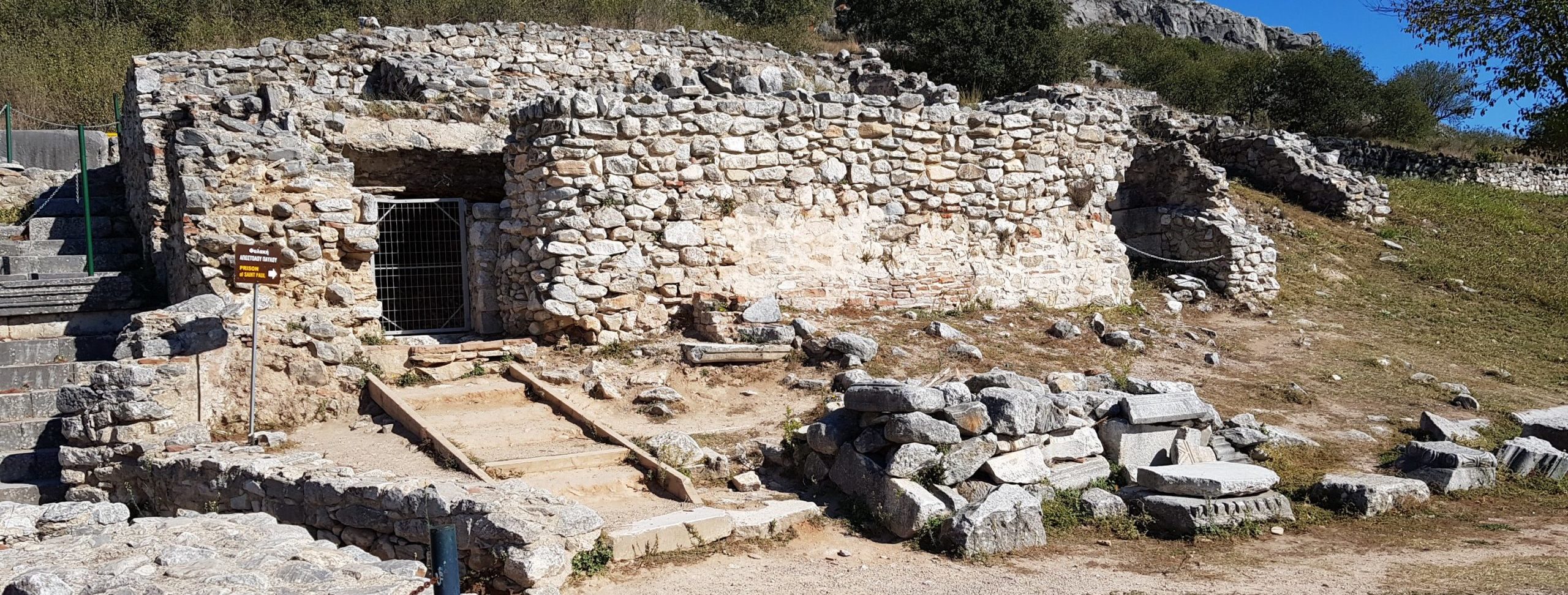
Paul and Silas Jailed in Philippi
While in Philippi, Paul and Silas met a slave girl who was demon possessed. Her owners made money off of her because the demon gave her the ability to function as a fortune-teller. For several days she followed Paul and Silas around, declaring that Paul and Silas were preachers of the one true God (Acts 16:16-18).
Paul cast the demon out of her. The girl’s owners realized that they wouldn’t make any more money from her, because she could no longer function as a fortune-teller. They were angry so they took Paul and Silas to the magistrates. Paul and Silas were beaten with rods and thrown into jail. Paul had previously been beaten and persecuted, but this marked the first time he was officially imprisoned (Acts 16:18-24).
While in prison, Paul and Silas prayed and sung hymns to the Lord. As they sang and prayed many of the other prisoners listened. Late in the night an earthquake occurred, this earthquake not only opened all the doors but broke their chains.
The jailer believed that all the prisoners had escaped and was about to kill himself (the Romans would’ve blamed the guard and likely would’ve executed him). But Paul and Silas stopped him and told him that no one had escaped. Then the jailer responded asking how to be saved.
And they said, “Believe in the Lord Jesus, and you will be saved, you and your household.” —Acts 16:31
God turned the persecution into an opportunity for gospel proclamation. Paul and Silas were not only able to witness to the jailer but all the prisoners listening to their hymns and prayers throughout the night. Paul went to the jailers home to preach and several people came to faith (Acts 16:25-34).
When the town magistrates learned that Paul and Silas were Roman citizens, the magistrates apologized for having unlawfully imprisoned them. This was a public vindication (of sorts) for Paul and Silas. Before leaving, Paul and Silas spent more time with Lydia and the other new converts in the region, encouraging them in the faith (Acts 16:35-40).
Thessalonica
Next, Paul and his crew passed through Amphipolis and Apponia and came to Thessalonica (Acts 17:1). As was his habit, Paul first went to the synagogue to preach to the Jews. He preached there on three consecutive Sabbath days. Many people believed, including many Gentiles.
Yet again, as Paul had seen before, many Jews became angry and jealous, and they caused an uproar. One of the brothers that had welcomed Paul was a man named Jason. The Jews dragged Jason before the city’s leaders. Jason was eventually released.
Paul and Silas left the city. It does seem that the church in Thessalonica continued to face persecution and trouble from their countrymen, but they flourished anyway. We read these words in Paul’s letter to the church:
For you, brothers, became imitators of the churches of God in Christ Jesus that are in Judea. For you suffered the same things from your own countrymen as they did from the Jews. —1 Thess. 2:14
Berea
Paul and his crew went to Berea. There, Paul yet again started in the Jewish synagogue, but this time he got a different response. Instead of jealousy and mobs, the Jews there examined the Scriptures to see if what Paul was saying was true. Many believed in Jesus.
Paul praised their willingness to study and pursue truth. Luke says the Jews of Berea were “more noble” than the Jews of Thessalonica (Acts 17:11).
Things seem to be going well. Many people became Christians. But the Jews from Thessalonica heard that Paul was teaching in Berea and they came to stir up the crowds and trouble. Paul was sent away by the brothers there, but Silas and Timothy stayed behind (Acts 17:13-14).
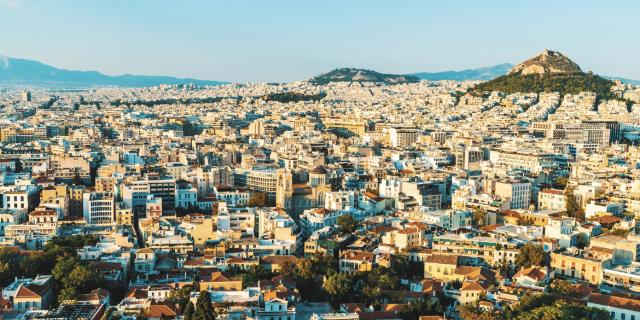
Traveling in Achaia
The apostle Paul was then escorted by some brothers more than 300 miles south, into the region of Achaia, reaching the city of Athens. When they arrived in Athens, the brothers headed back. Paul stayed in Athens, but told the brothers to tell Silas and Timothy that he wanted them to join him as soon as possible (Acts 17:15).
While Paul waited for Silas and Timothy, Paul’s “spirit was provoked within him” (Acts 17:16) because he saw an abundance of idols in the region.
Paul decided to make the best use of his time and talked with the Jews at the synagogue and preached to many Gentiles in the marketplace (Acts 17:17). Paul also talked with Epicurean and Stoic philosophers (Acts 17:18). They eventually brought Paul to the Areopagus, the court where men discussed philosophy, civics, and religion.
In the court of the Areopagus, Paul preached one of his most famous sermon (Acts 17:22-31). Paul’s sermons included quotes from famous Greek philosophers that they would have been familiar with. This gives us insights into Paul’s knowledge of their culture and insights into Paul’s missiology.
After hearing Paul’s sermon, there were some there who laughed at him, but there were also some who believed the gospel and joined Paul (Acts 17:32-34).
First Visit to Corinth
After leaving Athens, Paul traveled 53 miles southwest to Corinth. By this point in his second missionary journey, Paul had traveled more than 1,500 miles.
The apostle Paul probably arrived in Corinth apx. 8-12 months after the start of the second missionary journey, therefore, it’s likely that he got there sometime late in the year of 51 A.D. (or maybe sometime early in 52 A.D., depending on how we date his departure from Antioch in Syria). Paul stayed in Corinth for a year and a half (Acts 18:11), so Paul was likely in Corinth until the summer or fall of 53 A.D.
Silas and Timothy also rejoined Paul in Corinth.
While in Corinth, Paul met two Jews from Rome, Aquila and Priscilla. Like the apostle Paul, Aquila and Priscilla were also tentmakers. Paul stayed with them and worked while also going to the synagogues on the Sabbath to preach, seeking to convert both Jews and Greeks (Acts 18:1-4).
Paul faced some opposition from Jews in Corinth (Acts 18:5-9), but many people in the city believed anyway. Paul may have been considering leaving the city, but he stayed in Corinth after having received a vision from God that told him that “no one will attack or harm you” (Acts 18:10).
While in Corinth the apostle Paul wrote his letters to the Thessalonians, encouraging the new believers there to stand firm under the pressure and pain of persecution. He gives them instructions on how to live a godly lifestyle and gives doctrinal teaching about the future second coming of Christ.
Paul continued to preach the word of God faithfully for those 18 months. Many were saved and the church was established. But many Jews were upset.
The Jews of Corinth eventually tried to bring the apostle Paul before the Roman proconsul Gallio, who happened to be the older brother of the renowned dramatist and philosopher Seneca (the tutor of Emperor Nero). Gallio refused to even hear their case against Paul and sent them away (Acts 18:12-17).
Paul stayed in Corinth for “many days longer” (Acts 18:18) after being brought before Gallio. He then started his journey back home to Antioch in Syria, but planned to first make a stop in Ephesus. Priscilla and Aquila came with him.
Leaving from Cenchreae
Paul’s crew traveled to the nearby port city of Cenchreae, just eight miles from Corinth. We don’t know how long they stayed in Cenchreae, but they were there long enough for Paul to have his head shaved as part of a vow (Acts 18:18). It’s possible that this stop was very brief, but it’s also possible that they spent some time preaching and ministering there in the city.
There does seem to be some evidence that Paul spent some significant time in Cenchreae. But we cannot be certain. Also, we’re not sure if he spent time there during this second missionary journey or if that happened at a later time during his third missionary journey.
Brief Visit to Ephesus
When Paul arrived in Ephesus, he went into the synagogue to talk with the Jews about Jesus. His visit to Ephesus was brief. They requested that he stay in the city longer. He declined but said, “I will return to you if God wills” (Acts 18:21). Paul made plans to leave, but Priscilla and Aquila stayed in the city.
Paul traveled from Ephesus to Caesarea. Once he was there he visited with the believers in the region and preached the gospel in various towns and places. He briefly visited Jerusalem and then traveled back home to Antioch in Syria.
Paul’s second missionary journey lasted between two and a half years and three years, and likely ended back in Antioch sometime in the fall of 53 A.D. (or maybe early 54 A.D.).
Paul’s Third Missionary Journey
After getting back from his second missionary journey, the apostle Paul stayed Antioch for “some time” (Acts 18:23). Maybe just a few weeks or few months. He then launched his third missionary journey (Acts 18-21).
Paul likely left for his third missionary journey in the spring of 54 A.D. This third missionary journey was probably more than four years long and ended with Paul in Jerusalem in 58 A.D.
Galatia and Phrygia
Paul began his third missionary trip by visiting many of the same locations that he had visited on his first and second missionary journeys. We don’t know his exact route, but it’s likely he began by traveling through the region of Cilicia and through the city of Tarsus, on the way toward Galatia.
He spent several months traveling to the churches throughout the regions of Galatia and Phrygia, “strengthening all the disciples” (18:23). Paul passed through the “inland” route through Asia and traveled west to Ephesus (Acts 19:1).
Three Years in Ephesus
Paul spent three labor-intensive years in Ephesus (Acts 20:31). Paul was likely in Ephesus from the fall of 54 A.D. to the fall of 57 A.D.
Paul’s time in Ephesus was hard. He later says that he experienced many “afflictions” and he wasn’t confident that he would live through this season (2 Cor. 1:6-10). But God did many great things through Paul while he was in Ephesus.
For the first few months of Paul’s ministry in Ephesus, he spent time preaching in the synagogue. That was his focus. However there were many Jews stuck in unbelief, and they said evil things about Paul and the gospel message. So Paul decided to spend the last two and half years of his time in Ephesus preaching in the hall of Tyrannus, instead of the synagogue. He preached in the hall of Tyrannus daily and “all residents of Asia heard the word of the Lord” (Acts 19:10).
During Paul’s ministry, he performed many miracles in the name of Jesus, leading many to believe.
“God was doing extraordinary miracles by the hands of Paul… even handkerchiefs or aprons that had touched [Paul’s] skin were carried away to the sick, and their diseases left them and the evil spirits came out of them.” —Acts 19:11-12
God-Fearers Received the Holy Spirit
One of the most famous events from Paul’s time in Ephesus was when he corresponded with a group of disciples that had known about John’s baptism (referring to John the Baptist), but they did not know about Jesus (Acts 19:1-3). These types of believers were sometimes referred to as God-fearers.
These God-fearers had previously been taught by a great preacher named Apollos. He had taught them to revere the one true God, the God of Israel. But Apollos himself had not known about Jesus until after he had preached to this particular group of disciples. Apollos was later instructed by Paul’s friends, Priscilla and Aquila (Acts 18:24-28).
Paul taught this particular group about Jesus. They believed and received the Holy Spirit (Acts 19:4-7).
The Sons of Sceva
Another event that the book of Acts highlights, from Paul’s time in Ephesus, is about seven traveling Jewish exorcists, the sons of Sceva. These exorcists came across a demon-possessed man. They attempted to cast-out the demons (Acts 19:11-14). But one of the demons responded to them, “Jesus I know, and Paul I recognize, but who are you?” (Acts 19:15).
The demon-possessed man (under the control of the evil spirits) attacked the seven men and badly beat them (Acts 19:16). This caused many people in the region to respect Paul and his ministry. Many of the magicians in the area repented and burned their magic books (Acts 19:17-19) and “the word of the Lord continued to increase in the region” (Acts 19:20).
Demetrius, Riots, and Leaving Ephesus
Paul was planning to leave Ephesus. However, before he left Ephesus, a silversmith named Demetrius caused trouble. Demetrius made and sold idols. Paul preached against idolatry, so many people stopped buying Demetrius’ idols. This cost him money. Demetrius clearly was not happy.
There were other business owners that were also hurt financially because of Paul’s preaching. Many people had stopped buying their idols as they responded to the gospel. When these merchants got together, they started a massive riot in the city.
Paul wanted to go into the crowd to calm them down, but the disciples would not let him because they knew that Paul could get killed. Some of the Christians went into crowd and calmed the riot. Shortly after these riots, Paul set sail for Macedonia (Acts 19:21-20:1).

The “Painful” Visit
Paul had made plans to travel through Macedonia and then southward into Achaia (1 Cor. 16), which would likely include a visit to the church in Corinth.
At some point, Paul received some correspondence telling him that there were massive problems in the church of Corinth. How did Paul respond when he received this news? There are two main views from scholars.
View #1: Paul immediately changed plans and left from Ephesus to Corinth.
Some scholars argue that as soon as Paul received word that there were big problems in Corinth, Paul changed his plans and decided to visit the Corinthians immediately, skipping his original plans to travel through Macedonia.
Paul probably thought that once he was there in Corinth, that he’d be able to resolve the conflicts. But it seems that the exact opposite happened. Paul would later describe this visit as “painful” (2 Cor. 2:1). During this “painful” visit Paul was deeply hurt by someone in the church (2 Cor. 2:5).
The scholars that embrace View #1 say that Paul then left Corinth after this “painful visit” and headed back to Ephesus for a brief period of time.
It then appears that Paul was contemplating returning to Corinth, yet again, before heading over to Macedonia, but Paul ultimately decided against this additional visit, in order to “spare” the Corinthians (2 Cor. 1:23). Paul defends this decision in 2 Corinthians (vv. 1:12-2:2).
Paul then left from Ephesus to Macedonia (Acts 20:1). However, Paul would eventually make a third visit back to Corinth a few months later toward the end of this journey.
These scholars typically piece it all together like this:
- Paul (while in Ephesus) receives news of trouble in the church of Corinth and changes his plans
- Travels from Ephesus to Corinth for a second visit (known as the “painful” visit)
- Travels from Corinth back to Ephesus
- Contemplates another visit to Corinth, but ultimately decides against it
- Experiences the Demetrius-led riots in Ephesus
- Travels onto to Macedonia
- Goes from Macedonia down into Greece
- Eventually makes it back to Corinth (third overall visit)
Scholars that hold to View #1 assert that Paul ultimately made three total visits to Corinth; his first visit (the 18 months he spent there during his second missionary journey), the “painful” visit from Ephesus, and then a third visit toward the end of this third missionary journey.
View #2: Paul did not change his plans, but visited Corinth later.
Scholars that hold to View #2 say that Paul likely received some communication from Corinth (that there were indeed big problems in the church), but these scholars conclude that receiving this communication did not cause Paul to visit Corinth immediately.
The scholars that embrace View #2 argue that Paul did consider changing his plans, which would have consisted of a visit to Corinth before going through Macedonia, but these scholars argue that ultimately Paul decided against going to Corinth immediately, so he stuck to his plans to travel through Macedonia. They interpret Paul’s words in 2 Corinthians (vv. 1:12-2:2) as Paul giving a defense as to why he did not visit them.
These scholars say that eventually Paul did visit Corinth, a few months later, toward the end of his third missionary journey. Scholars that embrace View #2 often say that the word “painful” (2 Cor. 2:1) was not a description of an actual visit that ever happened, but that it was a description of the type of visit that would have ensued if Paul had indeed visited them. He knew that if he did visit, it would have been painful, so he sought to “spare” them (2 Cor. 1:23).
These scholars typically piece it all together like this:
- Paul (while in Ephesus) receives news of trouble in the church of Corinth
- Contemplates an immediate visit to Corinth, but ultimately decides against it
- Experiences the Demetrius-led riots in Ephesus
- Goes from Ephesus to Macedonia
- Goes from Macedonia down into Greece
- Eventually travels to Corinth for his second visit
Scholars that hold to View #2 assert that Paul ultimately made two total visits to Corinth; his first visit (the 18 months he spent there during his second missionary journey) and then his visit to Corinth toward the end of this third missionary journey.
Leaving For Macedonia and the Sorrowful Letter
Paul leaves Ephesus and heads toward Macedonia. In the book of Acts, Luke gives us no details. He only says that Paul “departed for Macedonia” (Acts 20:1). However, by examining Paul’s letters, we get more insight into these travels.
It appears that, at some point during this journey, Paul had sent Titus to Corinth with a letter (this is sometimes referred to as the “sorrowful letter”). Paul later describes this “sorrowful” letter as having been written with “much affliction and anguish of heart and with many tears” (2 Cor. 2:4).
Some scholars contend that this “sorrowful letter” is the epistle that appears in the New Testament, that we know today as 1 Corinthians. Other scholars argue that the “sorrowful letter” is a separate correspondence that has been lost to history.
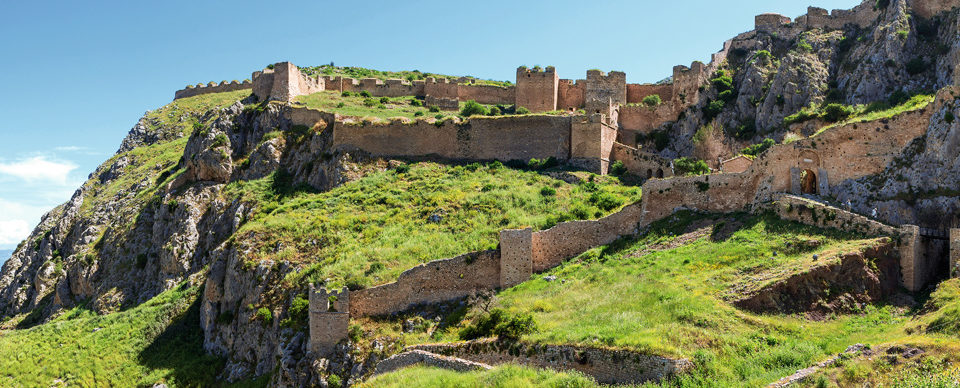
Ministry in Troas and Macedonia
On the way to Macedonia, Paul stopped in Troas to preach there and to await Titus’ return from Corinth. While waiting in Troas, Paul had great ministry opportunity. He called it an “open door” (2 Cor. 2:12).
However, when Titus’ return from Corinth appeared to be delayed, Paul was concerned for Titus’ safety. Paul decided to leave Troas and traveled to Macedonia to find Titus (2 Cor. 2:13).
Paul traveled throughout Macedonia, visiting the churches and friends in the region, and encouraging the believers in those churches (Acts 20:2).
Finally, while in Macedonia, Paul was reunited with Titus. Titus reported that many people in the church of Corinth had repented after hearing Paul’s letter (2 Cor. 2:5-11; 7:5-16). Paul was filled with joy.
However, Titus also reported that Paul’s opponents still wielded some influence over a small rebellious faction within the church questioning Paul’s authority and credibility. Paul responded to this faction by writing another letter (most likely from Philippi). This letter is in our New Testament, known today as 2 Corinthians.
Three Months in Greece
After these travels through Macedonia, the apostle Paul eventually traveled southward and finally arrived in Greece (i.e., Achaia). He stayed in the region for three months (Acts 20:2-3), including a lengthy stay in Corinth. This stay likely took place in late 57 A.D. or early 58 A.D.
While in Corinth, Paul wrote his theological masterpiece, the letter to the Romans.
As previously discussed in this article, some scholars believe that this was Paul’s second visit while others argue that this was his third visit.
Cenchreae and Phoebe
It’s also possible that during these three months in Achaia, Paul spent time in the nearby city of Cenchreae. In the book of Romans, Paul mentions Phoebe, a deaconess in the church of Cenchreae (Rom. 16:1).
Phoebe was the person that delivered Paul’s letter to the Romans, and Paul asked them to welcome her, praising her for being a “patron of many” (Rom. 16:2). It’s highly unlikely that Paul would have asked her to make this important delivery for him unless he knew her well and trusted her, pointing to the likelihood that Paul had spent time in Cenchreae before writing that letter.
As previously mentioned in this article, it’s also possible that Paul had spent some time in Cenchrea during his second missionary journey as well as this third missionary journey.
One More Lap Through Macedonia
After his time in Achaia, Paul had originally intended to sail directly to Jerusalem. Those plans were changed, however, when it was discovered that some of Paul’s opponents had been plotted against him. Paul decided to take another lap through Macedonia instead (Acts 20:3).
Paul had many companions with him, from various churches, which gave him protection while he traveled through Macedonia (Acts 20:4-5).
Throughout the spring of 58 A.D., Paul traveled through the Macedonian region, visiting towns such as Berea and Thessalonica, and eventually ending up in Philippi (again) during the “days of unleavened bread” (Acts 20:6).
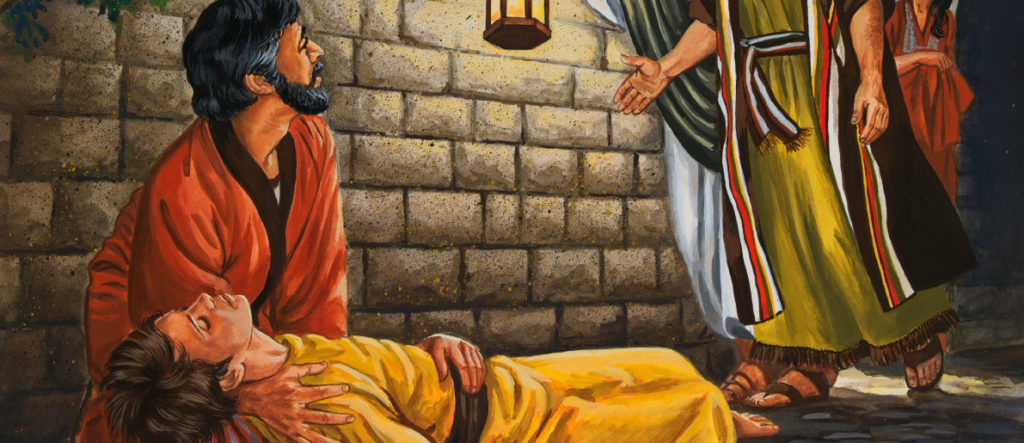
Eutychus Raises from the Dead at Troas
Paul and his companions then traveled to Troas (Acts 20:5). He ministered there again for a week. It was in Troas that a young man, Eutychus, was listening to one of Paul’s sermons and fell three stories out a window. When they found him he was dead on the ground, but Paul supernaturally restored life to this man (Acts 20:6-12).
After Troas, Paul’s companions went by ship to Assos, but Paul went by foot. Luke doesn’t tell us precisely why Paul did this. But what we do know is that distance from Troas to Assos was more than 30 miles through dangerous and mountainous terrain.
After meeting with his companions in Assos, they began their trek to Jerusalem. They made briefs stops in Chios and Samos, before arriving in Miletus (Acts 20:15).
Goodbye to the Ephesian Elders
It would make sense that Paul would have wanted to stop in Ephesus before heading to Jerusalem. considering the dear friends he had there, but he intentionally passed Ephesus because he wanted to be in Jerusalem by Pentecost, and he knew that traveling through Ephesus, and staying in Asia, would take much more time than he desired. In addition, he knew visiting Ephesus again could cause an uproar (Acts 20:13-16).
However, Paul did want to see his Ephesian friends and ministry partners, so when he arrived in Miletus, Paul called the elders from Ephesus to meet him there (Acts 20:17). In Miletus he encouraged the elders and commended them, letting them know that he would not be seeing them again since he knew that imprisonment and maybe death waited for him in Jerusalem. This was, no doubt, an emotional moment for Paul and his friends.
Paul had spent several years laboring with these men in ministry, and now he was saying goodbye for, what appeared to be, the last time. They wept and prayed together (Acts 20:17-38).
Sailing for Syria
From there, the apostle Paul and his companions then sailed towards Syria. They made brief stops in Cos, Rhodes, and Patara, before finally coming to Syria, landing at Tyre (Acts 21:1-3). Paul and his companions spent seven days with the disciples in Tyre. Through “the Spirit” they told Paul not to go onto Jerusalem, but Paul sensed that Jerusalem was the right place to go (Acts 21:4).
Then Paul and his companions went to Ptolemais (Acts 21:7), spending one day with the believers there, before heading onto Caesarea. There they were greeted by the believers there and they stayed with Philip the evangelist (Acts 21:8). While they were there, a prophet named Agabus came down from Judea and told Paul of the coming affliction he would face in Jerusalem (Acts 21:10-12).
Despite many people again urging Paul not to go to Jerusalem, Paul told them he knew what was instore and that he was ready to die.
Then Paul answered, ‘What are you doing, weeping and breaking my heart? For I am ready not only to be imprisoned but even to die in Jerusalem for the name of the Lord Jesus.’ —Acts 21:13
Paul and his companions then traveled to Jerusalem and was greeted by his brothers in Christ who lived there. He told the church there all God had been doing among the Gentiles (Acts 21:14-16). Once there, Paul visited with James and all the elders (Acts 21:17-18). He told them about all that God had done throughout the Gentiles.
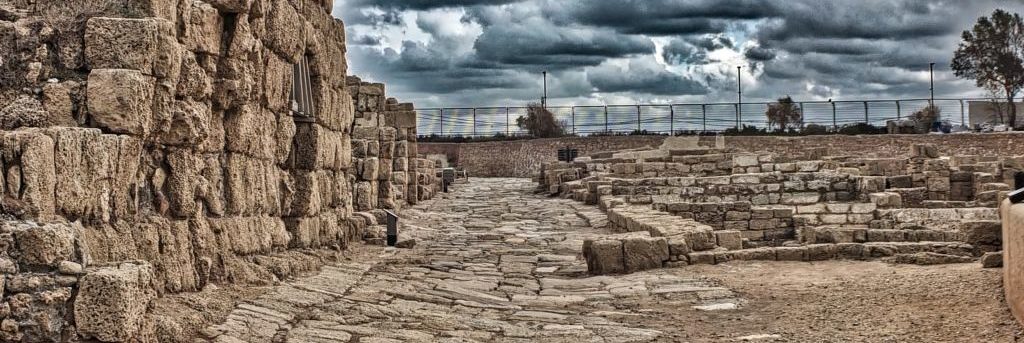
Arrested in Caesarea
While in Jerusalem, Paul went to the temple to worship and pray. While he was there, some Jews from Asia Minor stirred up trouble for Paul. They accused him of abandoning the one true God of Israel, of maligning the law of Moses, and of encouraging people to disobey the Jewish laws. Paul (obviously) denied this charge. This confrontation caused a riot in the temple. Paul was dragged out of the temple by a mob. The Romans then intervened and took Paul into custody (Acts 21:27-36).
Paul then addressed the crowd. He made it clear that he loved the law of God and that he had previously been a persecutor of Christians. But that he had become a preacher of the gospel after meeting Jesus on the road to Damascus. This caused another riot to erupt. The Romans then took Paul in their barracks. The Romans were going to flog him but Paul appeals to his own Roman citizenship (Acts 21:37-22:29).
On Trial Before Felix
Paul is taken to the Roman barracks in Caesarea. During this time the Roman governor over the region, Felix, brought Paul to trial. Ananias, the high priest, came from Jerusalem to bring charges against Paul. Felix gave Paul the opportunity to speak before the crowd. Paul shares his story and preaches truth. Felix was afraid of Paul’s message, so he doesn’t seemingly know what to do with Paul (Acts 23:23-35; 24:1-27).
Paul was imprisoned in Caesarea by the Romans for two years, but was given “some freedom” and his friends are allowed to visit him “to take care of his needs” (Acts 24:23).
On Trial Before Festus and Agrippa
When Festus became the governor of the region in 60 A.D. (or maybe earlier in 59 A.D.), he brought Paul back to trial. Some Jews came from Jerusalem again to bring charges against Paul, but they could not prove any of those charges (Acts 25:1-12).
King Herod Agrippa II visited with Festus. Festus asked him to hear Paul’s case. When Paul is called to defend himself, he gives one of his most famous defenses of the gospel and even encourages Agrippa to believe in Jesus (Acts 26:1-29). Agrippa famously responds, “Do you think that in such a short time you can persuade me to be a Christian?” (Acts 26:28). Paul says that he wants everyone to believe.
Festus calls Paul crazy (Acts 26:24), but both he and Agrippa agree that Paul had not done anything that might “deserve death or imprisonment” (Acts 26:31). Paul could have simply “been set free if he had not appealed to Caesar” (Acts 26:32). Paul had appealed to Caesar under his rights as a Roman citizen. This set into the motion the plans for Paul to be transported from Palestine to Rome to face trial in Caesar’s court.
Journey to Rome
After his appeal to Rome, the apostle Paul is transported from Caesarea to Rome by ship under Roman guard (Acts 27:1-28:10). Some Bible scholars allude to this journey as Paul’s fourth missionary journey, but I don’t believe that’s the best or most accurate description for this trip.
Paul’s trip to Rome was tumultuous, filled with difficulties, including a shipwreck that caused him to be deserted on the island of Malta for three months. He also consistently faced belligerent resistance from people that opposed the gospel.
Paul and his companions eventually made it to Rome, sometime around 61 A.D. (or maybe somewhat earlier). When Paul arrived in Rome, he was placed under house arrest for two years.
Paul lived in a rented house where he served his house arrest. There he is able to visit with friends and preach the gospel to those who visit. During this time he also writes several letters that are now in the New Testament, including Philippians, Ephesians, Colossians, and Philemon.
The book of Acts ends there, with Paul under house arrest in Rome (Acts 28:11-31).
Paul’s Fourth Missionary Journey
The fourth missionary journey is not outlined in the narratives of Scripture. And there are some scholars that question whether such a journey ever really happened (we’ll cover that a bit more later in this article).
We don’t have a clear picture of what happened next in Paul’s life, after he was released from house arrest. But by carefully examining Paul’s epistles, we can piece-it-together to some extent.
The early church father and historian Eusebius (writing in the 4th century) recorded that the most prominent church tradition had been that Paul was released from Roman house arrest and then re-arrested several years. According to this tradition, Paul traveled and did ministry in-between his imprisonments. His second arrest eventually led to his martyrdom, under the direction of Emperor Nero (see H.E. 2.22.6).
Pastoral Epistles
Paul’s later letters (1 & 2 Timothy and Titus) are commonly referred to as the Pastoral Epistles. They are clearly written after the events of the book of Acts. In those letters Paul makes comments about his travels and plans. Paul was likely released from his first imprisonment sometime around 63 A.D.
After his release, Paul then traveled extensively. During the latter stages of these travels is when Paul wrote 1 Timothy and Titus. He then eventually ends up being arrested and imprisoned in Rome a second time. From prison he writes 2 Timothy.
Asia
During his first imprisonment in Rome, Paul was clearly making plans to travel eastward. He asks Philemon to prepare a guest room for him (Philemon 22) and tells the Philippians that he intends to visit them (Phil. 2:24). Paul doesn’t strike me as the type of guy that would make plans in vain. Paul clearly anticipated his release from house arrest.
These plans to go east make perfect sense. Paul’s habit was to go back and encourage the churches that he had previously established. That’s what he’d done on previous journeys.
Later, in 2 Timothy, written during his second imprisonment, Paul mentions several people and moments that are most likely connected to his post-Roman arrest ministry travels through Asia. Paul mentions:
- Having a significant dispute with some believers in Asia, including Phygelus and Hermogenes (2 Tim. 1:15)
- Receiving help from Onesiphorus (2 Tim. 1:18)
- Having been with Carpus at Troas (2 Tim 4:13-14)
- Being confronted by Alexander the coppersmith (2 Tim. 4:14)
- Needing to leave Trophimus in Miletus because he was ill (2 Tim 4:20)
All of these events seem to have happened after Paul’s release from Roman house arrest.
Achaia
Paul says in 2 Timothy 4:20 that “Erastus remained at Corinth.” This is a clear statement that Paul had been in Corinth; he knew Erastus was there because he had first-hand knowledge, having recently visited the city.
In Titus 3:12, Paul invites Titus to join Paul in Nicopolis. Paul tells Titus that he plans on spending the winter in Nicopolis, a city in Achaia. Clearly, when Paul writes the letter to Titus he is already in Achaia or somewhere very close, hoping for Titus to meet him there.
Crete
In Paul’s letter to Titus, he alludes to having been in Crete and having left Titus in charge to help those churches flourish.
A few scholars have argued that Paul did ministry in Crete when he was shipwrecked there. Paul had been briefly shipwrecked in Crete while traveling from Caesarea to Rome, before his Roman house arrest (Acts 27).
However, Paul and the men from the shipwreck were in Crete just a short while. As we examine the events of the shipwreck, as they are described in the book of Acts, we see that Paul would not likely have had the opportunity to establish churches in the region during such a short period. Also, they didn’t travel throughout the island at all.
What seems much more likely is that Paul eventually made it back to the island of Crete, spend time preaching, establishing churches throughout the region, and that upon his departure Paul left Titus there to “complete [their] work there and appoint elders in each town” (Titus 1:5).
Macedonia
At the beginning of 1 Timothy Paul says “when I was going to Macedonia” (1 Timothy 1:3). When we examine this letter, we get the sense that he’s referring to events in the not-too-distant past. Seems likely Paul is referring to the moment when he had traveling to Macedonia after being released from Roman house arrest. After his time spent in Macedonia, he may have headed back to the church in Ephesus, which he asserted was his plan (1 Timothy).
Doubts about the Fourth Journey
There are clearly some comments in Paul’s letters that do not easily square with the events of the book of Acts, which means that those comments in his letters point to some missionary work that happened after Paul’s Roman house arrest.
However, a few scholars have argued that there’s significant (enough) overlap in the locations, types of events, and even the people mentioned during Paul’s first three journeys, therefore it’s hard to say for sure—they claim it’s possible that much of those things that do not seem to square with the events of the book of Acts can still potentially be things that happened on one of his first three missionary journeys.
Also, some scholars have sought to remind us that the apostle Paul spent long periods of time in some locations (like 18 months in Corinth and 3 years in Ephesus), and they’ve asserted it’s possible that many unrecorded things may have happened during those long stays, implying that those longer stays in those locations could account for some of the comments in Paul’s epistles.
These scholars claim there’s so much that we do not know about those time periods, that it’s entirely possible all of the events alluded to by Paul, in his own letters, took place during his first three journeys.
I happen to be confident that Paul did indeed take a fourth missionary journey, after his release from his Roman house arrest. I think that’s the best interpretation of the data we have. However, I also realize that there are some good New Testament scholars that don’t find the evidence as compelling as I do.

Potential Travel to Spain
Did Paul ever make it to Spain? We know from Scripture that the apostle Paul had a desire to preach in Spain (Rom. 15:22-29). After being released from Roman house arrest, he could have easily sailed westward.
Clement of Rome (writing in 95 A.D.) says that Paul had traveled and preached in “the farthest limits of the West” (1 Clement 5:5-7). This sort of language could have described a location west of Italy, such as Gaul or Britannia, but most scholars seem to think this describes Spain. However, it is also possible that Clement was speaking more broadly (or generically), referring to Paul traveling far westward from his home region, going from Palestine through much of the heart of the Roman Empire and eventually all the way to Rome. This latter interpretation seems odd to me.
The Muratorian fragment (written in apx. 170 A.D.), seems to affirm Paul’s missionary journey to Spain too, but some scholars question this; just because someone in the mid-to-late second century believed it doesn’t necessarily equate to strong evidence. However, this shows that church tradition was handing this down through the generations.
Paul’s missionary trip to Spain is also mentioned by Cyril of Jerusalem (313-386) and John Chrysostom (347-407).
There may not seem to be many significant (quality) pieces of evidence that corroborate the idea that Paul made it all the way to Spain, and there are not any comments in Paul’s later letters that point to him ever making it to Spain either. However, these extrabiblical evidences seem compelling. It’s possible that a trip to Spain may have been the first leg of Paul’s fourth missionary journey.
Paul Beheaded by Nero
In his second letter to Timothy, Paul mentions his “first defense” and says he was “delivered from the lion’s mouth” (2 Tim. 4:16-17). Most biblical scholars believe this is a reference to the first time he was in Caesar’s court, defending himself, eventually leading to his Roman house arrest (Acts 28).
Paul was released from his first Roman arrest, but there wouldn’t be a second release. Paul eventually ended up back in Rome. The second time, it wasn’t house arrest. It was a real Roman jail. This was most likely part of Nero’s persecution of Christians in the mid 60s. This was one of the most brutal times of persecution in Christian history.
When much of the city of Rome burned down in 64 A.D., Emperor Nero blamed the Christians. The emperor later requested that the apostle Paul be arrested and chained. It appears that Paul was arrested somewhat abruptly and unexpectedly, evidenced by the fact that he was not able to secure his cloak and his Old Testament parchments; Paul later requested that these be brought to him (2 Tim. 4).
As previously mentioned, Paul most likely penned 2 Timothy during this second Roman imprisonment. He was beheaded shortly after he wrote that epistle. Some scholars have concluded that Paul was killed as early as 64 A.D., but it is more likely that he was executed sometime between 67 A.D. and 68 A.D.
Conclusion
The legacy of the apostle Paul is second to none in Christian history. He is the greatest missionary evangelist the world has ever seen. Paul was a man on mission, focused on spreading the gospel and planting churches.
Paul was a man so impacted by Jesus, so compelled by God’s love, so humbled that the Messiah would choose him to be an ambassador, that he was willing to endure much pain and hardship to see others come to faith in Jesus Christ.
Featured illustration of Paul in prison courtesy of britannica.com. Images of the jails in Philippi and Caesarea courtesy of missionbibleclass.org. Illustration of Eutychus’ death courtesy of gfbtkingdomkids.com.
Recommended Resources:
“Handbook on Acts and Paul’s Letters” (by Thomas R. Schreiner)
“Paul: A Biography” (by N.T. Wright)
“Acts: An Expositional Commentary” (by R.C. Sproul)
Kenneth E. Ortiz (Th.M.) is Lead Pastor of Horizon City Church and Ph.D. Candidate at Midwestern Seminary. He has 15+ years of vocational ministry experience. Kenneth previously served as a professor at Bethlehem College and adjunct faculty at Spurgeon College. Kenneth lives in Minneola, FL with his wife Malaina, they have three kids.

